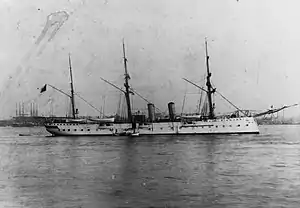Italian corvette Cristoforo Colombo (1892)
Cristoforo Colombo was a steel-hulled corvette built in the early 1890s for the Italian Regia Marina (Royal Navy). The ship was built as a replacement for an earlier vessel of the same name, based on a nearly identical design. The new ship was intended to serve in Italy's colonial empire in eastern Africa, and was designed to be able to operate at long range, far from home ports, for an extended period of time.
 Cristoforo Colombo in 1896 | |
| Class overview | |
|---|---|
| Name: | Cristoforo Colombo |
| Builders: | Venice Naval Yard |
| Operators: | Regia Marina (Royal Navy) |
| Preceded by: | Amerigo Vespucci |
| Completed: | 1 |
| History | |
| Name: | Cristoforo Colombo |
| Builder: | Venice Naval yard |
| Laid down: | 1 September 1890 |
| Launched: | 24 September 1892 |
| Completed: | 16 October 1894 |
| Fate: | Discarded 10 March 1907 |
| General characteristics | |
| Type: | Corvette |
| Displacement: | 2,713 long tons (2,757 t) |
| Length: | 76.4 meters (251 ft) pp |
| Beam: | 11.3 m (37 ft) |
| Draft: | 5.69 m (18.7 ft) |
| Installed power: |
|
| Propulsion: | 1 shaft reciprocating |
| Speed: | 13 knots (24 km/h; 15 mph) |
| Complement: | 238 |
| Armament: |
|
The Regia Marina ultimately sold the ship in March 1907, though her ultimate fate is unknown.
Design
In the late 1880s, the Italian Regia Marina's chief designer, Benedetto Brin, prepared the design for a new corvette to replace the earlier Cristoforo Colombo. Brin's new design was an essential copy of the earlier vessel, though with a steel hull instead of the wooden one used in the old corvette. The Regia Marina intended to use the new ship as a colonial station ship in the Red Sea to help control Italian Eritrea.[1]
Characteristics
Cristoforo Colombo was 76.4 meters (251 ft) long between perpendiculars, with a beam of 11.3 m (37 ft) and a draft of 5.69 m (18.7 ft). She displaced 2,713 long tons (2,757 t) at full load. Her steel hull was sheathed in copper to reduce biofouling, which was necessary for a ship intended to be stationed far from the level of maintenance facilities in home ports. Cristoforo Colombo had a crew of 238 officers and enlisted men.[1]
The ship was powered with the same machinery used in the older Cristoforo Colombo, though it produced a lower speed. The engine, which drove a single propeller shaft. Steam was provided by six boilers that were ducted into a pair of funnels. The propulsion system produced a top speed of 13 knots (24 km/h; 15 mph) from 2,321 indicated horsepower (1,731 kW).[1] Coal storage capacity amounted to 445 long tons (452 t).[2] To supplement the steam engine, particularly on long voyages to and from Italy's colonial empire, Cristoforo Colombo carried a barque sailing rig.[1]
Cristoforo Colombo carried a relatively heavy gun battery for her small size, including eight 120-millimeter (4.7 in) 40-caliber guns in single mounts, mounted in sponsons on each broadside. Later in the ship's career, two of these guns were removed. In addition to those guns, she carried two 75 mm (3.0 in) 24-caliber guns.[1]
Service history
The keel for Cristoforo Colombo was laid down on 1 September 1890, and her completed hull was launched on 24 September 1892. Fitting-out work was completed on 16 October 1894, after which the ship entered service with the Regia Marina.[1] As of 1902, Cristoforo Colombo was assigned to African waters along with the gunboat Volturno, stationed in Italian Somaliland.[3] By 1904, she had been transferred to the Red Sea station in Italian Eritrea, along with Volturno, the torpedo cruiser Coatit, and the aviso Galileo.[4] The Regia Marina discarded the ship on 10 March 1907. Her ultimate fate is unknown.[1]
Notes
- Gardiner, p. 346
- Brassey, p. 237
- "Naval Notes" (1902), p. 1075
- "Naval Notes" (1904), p. 1429
References
- Brassey, Thomas A. (1907). "List of British and Foreign Ships". The Naval Annual. Portsmouth: J. Griffin and Co.: 191–266. OCLC 6000656.
- Gardiner, Robert, ed. (1979). Conway's All the World's Fighting Ships: 1860–1905. London: Conway Maritime Press. ISBN 0-85177-133-5.
- "Naval Notes". Journal of the Royal United Service Institution. London: J. J. Keliher. XLVI: 1060–1079. 1902. OCLC 8007941.
- "Naval Notes". Journal of the Royal United Service Institution. London: J. J. Keliher & Co. XLVIII (322): 1418–1434. 1904. OCLC 8007941.